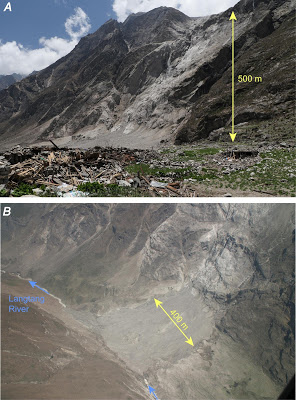
The April 2015 Gorkha earthquake that struck Nepal produced less damage and weaker shaking than might be expected from a magnitude 7.8 quake in the area, according to a group of ten new articles published this week in Seismological Research Letters.
In a region of major faulting and massive tectonic plate collisions, with an especially dense population centered on the country’s capital of Kathmandu, seismologists had expected the worst from a major earthquake. And the quake and its major aftershocks did cause more than 8,000 fatalities, 22,000 injuries and hundreds of thousands of collapsed or damaged buildings. But the damage was not as catastrophic as expected, said U.S. Geological Service geophysicist Susan Hough, guest editor of the Gorkha focus section papers.
“The world community of earthquake professionals expected an earthquake like this directly beneath Nepal would take a far greater toll on property and lives. So it poses a major challenge to understand and explain the shaking from the earthquake,” said Hough.
Hough and others conclude that the shaking was less damaging than expected because of how the Kathmandu valley’s “bowl” of ancient lake bed sediments responded. “We know that valleys like this greatly amplify shaking from small and moderate earthquakes, but in very large earthquakes, something that we call a nonlinear effect kicks in,” Hough said.
“We can think about the valley as a bowl of jello that shakes, but in a very big earthquake a valley is more like a bowl of sand,” she explained. “When shaken strongly, the grains aren’t able to transmit energy in the same way that a solid rock does.”
Other papers in the SRL focus section map out the main earthquake’s rupture within the Himalayan area’s complex fault system, concluding that the fault broke adjacent to the rupture from a 1934 magnitude 8.0 -8.4 earthquake. The historical and geologic record suggests that much larger earthquakes have occurred both east and west of the fault.
Scientists studying the earthquake combined data from the sparse seismic stations within Nepal with global observations and swift fieldwork. In some cases, the data were collected by cutting-edge “earthquake science from space,” such as the before-and-after satellite imagery of the region, reported in a study by Jet Propulsion Laboratory researcher Sang-Ho Yun and colleagues. Newspaper and other accounts provided a wealth of information that Earth Observatory of Singapore researcher Stacey Martin and his colleagues considered in detail to map out the severity of shaking throughout Nepal and neighboring countries.
In other cases, researchers were quickly out on to the precarious roads of Nepal to survey effects of the earthquake in Kathmandu as well as rural villages . Robb Moss of Cal Poly Pomona and his colleagues examined soil liquefaction within Kathmandu valley and several key landslide sites, and University of Nevada researcher Steven Angster and his team confirmed initial indications that the fault rupture did not reach the surface.
Eric Thompson, Brian Collins and Randy Jibson of the USGS collected extensive data on landslides, one of the largest causes of infrastructure damage from the earthquake. Thompson said that the scientists consulted satellite images and news reports and undertook extensive helicopter surveillance to assess the severity and locations of landslides throughout the mountainous region.
A study led by Rémy Bossu of the European Mediterranean Seismological Centre suggests that smartphone apps and Twitter also played a unique role in collecting information about the earthquake and especially its aftershocks. Bossu and colleagues analyzed how the LastQuake smartphone app gathered eyewitness accounts of the earthquake and provided hazard updates, using thumbnail images instead of more elaborate text surveys to collect information from its users. With this input from the app users, LastQuake was able to publish a map of the earthquake’s epicenter within minutes of the mainshock.
Bossu and colleagues say the two-way, real-time communication channel offered by apps like LastQuake can be useful to understanding the extent of an earthquake, as well as offer rapid advice to people to avoid the immediate risks from shaking.
Note: The above post is reprinted from materials provided by Seismological Society of America.










